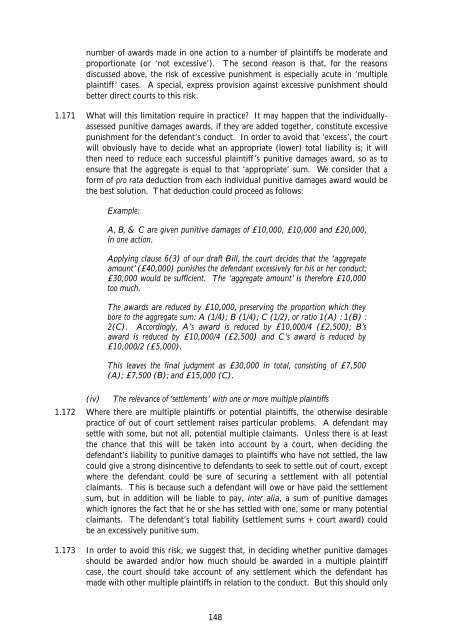Aggravated, Exemplary and Restitutionary ... - Law Commission
Aggravated, Exemplary and Restitutionary ... - Law Commission
Aggravated, Exemplary and Restitutionary ... - Law Commission
You also want an ePaper? Increase the reach of your titles
YUMPU automatically turns print PDFs into web optimized ePapers that Google loves.
number of awards made in one action to a number of plaintiffs be moderate <strong>and</strong><br />
proportionate (or ‘not excessive’). The second reason is that, for the reasons<br />
discussed above, the risk of excessive punishment is especially acute in ‘multiple<br />
plaintiff’ cases. A special, express provision against excessive punishment should<br />
better direct courts to this risk.<br />
1.171 What will this limitation require in practice? It may happen that the individuallyassessed<br />
punitive damages awards, if they are added together, constitute excessive<br />
punishment for the defendant’s conduct. In order to avoid that ‘excess’, the court<br />
will obviously have to decide what an appropriate (lower) total liability is; it will<br />
then need to reduce each successful plaintiff’s punitive damages award, so as to<br />
ensure that the aggregate is equal to that ‘appropriate’ sum. We consider that a<br />
form of pro rata deduction from each individual punitive damages award would be<br />
the best solution. That deduction could proceed as follows:<br />
Example:<br />
A, B, & C are given punitive damages of £10,000, £10,000 <strong>and</strong> £20,000,<br />
in one action.<br />
Applying clause 6(3) of our draft Bill, the court decides that the ‘aggregate<br />
amount’ (£40,000) punishes the defendant excessively for his or her conduct;<br />
£30,000 would be sufficient. The ‘aggregate amount’ is therefore £10,000<br />
too much.<br />
The awards are reduced by £10,000, preserving the proportion which they<br />
bore to the aggregate sum: A (1/4); B (1/4); C (1/2), or ratio 1(A) : 1(B) :<br />
2(C). Accordingly, A’s award is reduced by £10,000/4 (£2,500); B’s<br />
award is reduced by £10,000/4 (£2,500) <strong>and</strong> C’s award is reduced by<br />
£10,000/2 (£5,000).<br />
This leaves the final judgment as £30,000 in total, consisting of £7,500<br />
(A); £7,500 (B); <strong>and</strong> £15,000 (C).<br />
(iv) The relevance of ‘settlements’ with one or more multiple plaintiffs<br />
1.172 Where there are multiple plaintiffs or potential plaintiffs, the otherwise desirable<br />
practice of out of court settlement raises particular problems. A defendant may<br />
settle with some, but not all, potential multiple claimants. Unless there is at least<br />
the chance that this will be taken into account by a court, when deciding the<br />
defendant’s liability to punitive damages to plaintiffs who have not settled, the law<br />
could give a strong disincentive to defendants to seek to settle out of court, except<br />
where the defendant could be sure of securing a settlement with all potential<br />
claimants. This is because such a defendant will owe or have paid the settlement<br />
sum, but in addition will be liable to pay, inter alia, a sum of punitive damages<br />
which ignores the fact that he or she has settled with one, some or many potential<br />
claimants. The defendant’s total liability (settlement sums + court award) could<br />
be an excessively punitive sum.<br />
1.173 In order to avoid this risk, we suggest that, in deciding whether punitive damages<br />
should be awarded <strong>and</strong>/or how much should be awarded in a multiple plaintiff<br />
case, the court should take account of any settlement which the defendant has<br />
made with other multiple plaintiffs in relation to the conduct. But this should only<br />
148
















